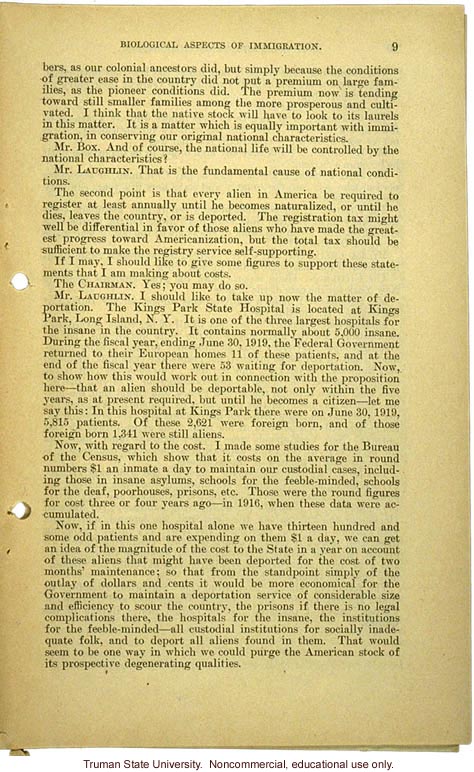Biological Aspects of Immigration. 9
bers, as our colonial ancestors did, but simply because the conditions of greater ease in the country did not put a premium on large families as the pioneer conditions did. The premium now is tending toward still smaller families among the more prosperous and cultivated. I think that the native stock will have to look to its laurels in this matter. It is a matter which is equally important with immigration, in conserving our original national characteristics.
Mr. Box. And of course, the national life will be controlled by the national characteristics?
Mr. Laughlin. That is the fundamental cause of national conditions.
The second point is that every alien in America be required to register at least annually until he becomes naturalized, or until he dies, leaves the country, or is deported. The registration tax might well be differential in favor of those aliens who have made the greatest progress toward Americanization, but the total tax should be sufficient to make the registry service self-supporting.
If I may, I should like to give some figures to support these statements that I am making about costs.
The Chairman. Yes; you may do so.
Mr. Laughlin. I should like to take up now the matter of deportation. The Kings Park State Hospital is located at Kings Park, Long Island, N. Y. It is one of the largest hospitals for the insane in the country. It contains normally about 5,000 insane. During the fiscal year, ending June 30, 1919, the Federal Government returned to their European homes 11 of these patients, and at the end of the fiscal year there were 53 waiting for deportation. Now, to show how this would work out in connection with the proposition here - that an alien should be deportable, not only within the five years, as at present required, but until he becomes a citizen - let me say this: In this hospital at Kings Park there were on June 30, 1919, 5,815 patients. Of these 2,621 were foreign born, and of those foreign born 1,341 were still aliens.
Now, with regard to the cost. I made some studies for the Bureau of the Census, which show that it cost on the average in round numbers $1 an inmate a day to maintain our custodial cases, including those in insane asylums, schools for the feeble-minded, schools for the deaf, poorhouses, prisons, etc. Those were the round figures for cost three or four years ago - in 1916, when these data were accumulated.
Now, if in this one hospital alone we have thirteen hundred and some odd patients and are expending on them $1 a day, we can get an idea of the magnitude of the cost to the State in a year on account of these aliens that might have been deported for the cost of two months' maintenance; so that from the standpoint simply of the outlay of dollars and cents it would be more economical for the Government to maintain a deportation service of considerable size and efficiency to scour the country, the prisons if there is no legal complications there, the hospitals for the insane, the institutions for the feeble-minded - all custodial institutions for socially inadequate folk, and to deport all aliens found in them. That would seem to be one way in which we could purge the American stock of its prospective degenerating qualities.


